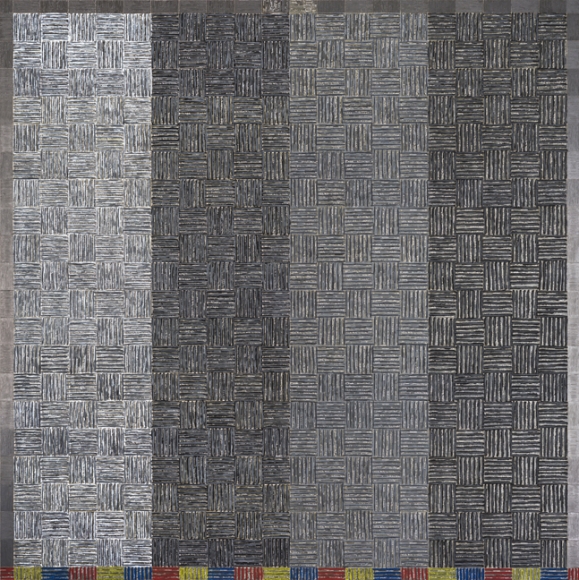
McArthur Binion, DNA: Black Painting: 1, 2015, Oil paint stick, graphite, and paper on board, 84 x 84 in., The Phillips Collection, Director’s Discretionary Fund, 2016
Though McArthur Binion’s work shares many tenets with the canons of Modernism—and particularly Minimalism—he subverts the dominant rigid notions of the avant-garde by extracting images and rhythms from varied sources including personal narrative, jazz music, and memory. “The part I took from Minimalism,” Binion said, “is that you want to do your own stuff in your own image.” Equally important to Binion is the integration of personal “DNA,” which is evident in the choice of birth certificate and the long history of artistic colleagues, art world luminaries and friends, living and deceased, glimpsed in the pages of the address book.
Early on Binion found his way to abstraction via drawing the body. The process of applying the surface is laborious and time consuming, recalling the manual labor of his youth and its landscape. Binion has described this as “an intangible and performative approach to making art.” For Binion, abstraction is not a fixed code, but an immensely mutable system in which questions of identity, birth, and existence can be examined and resolved, or left open to mystery.
Binion’s new paintings continue his DNA series, begun in 2013. Identity and the artist’s history is inscribed in the paintings not only via the traces of birth certificates and names from his address book but also through the physicality of the painting process and proportions that mimic the artist’s body. In DNA: Black Painting: I, the painting is divided into four equal vertical parts, each width roughly corresponding to the width of the artist’s thin body. These strong verticals contrast with the vibration of grids and traces of the artist’s handwriting from the address book pages. The obsessive movements of the artist’s hand and the fluid motion of hand writing as well as the size of the painting define DNA in numerous ways. Asserting presence may be a given for many, but for Binion, and other African American artists of his generation, the artist’s presence and their experience was often defined by absence. For this reason, another symbol in Binion’s work is the inclusion of his own self portrait. The source of this image is a photograph from 1971. It is reproduced in both horizontal and vertical lines, in serial format, introducing personal and emotional data in the language of Minimalism.
